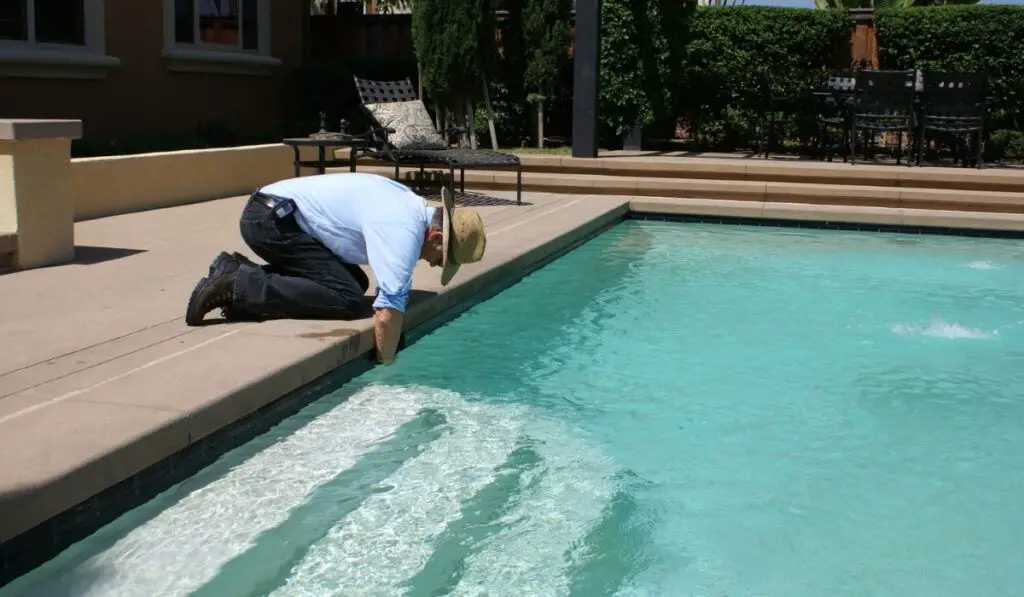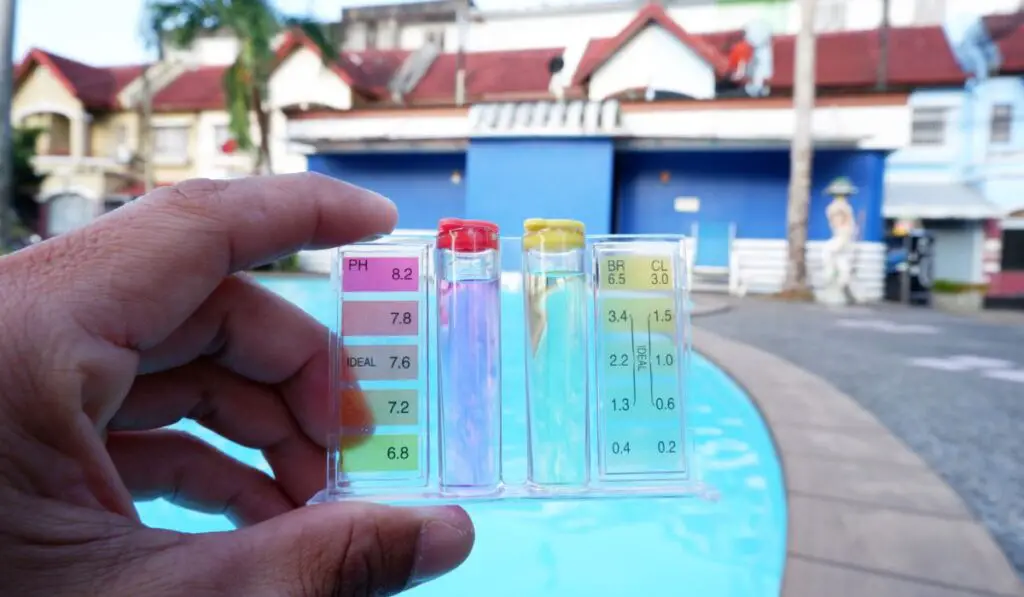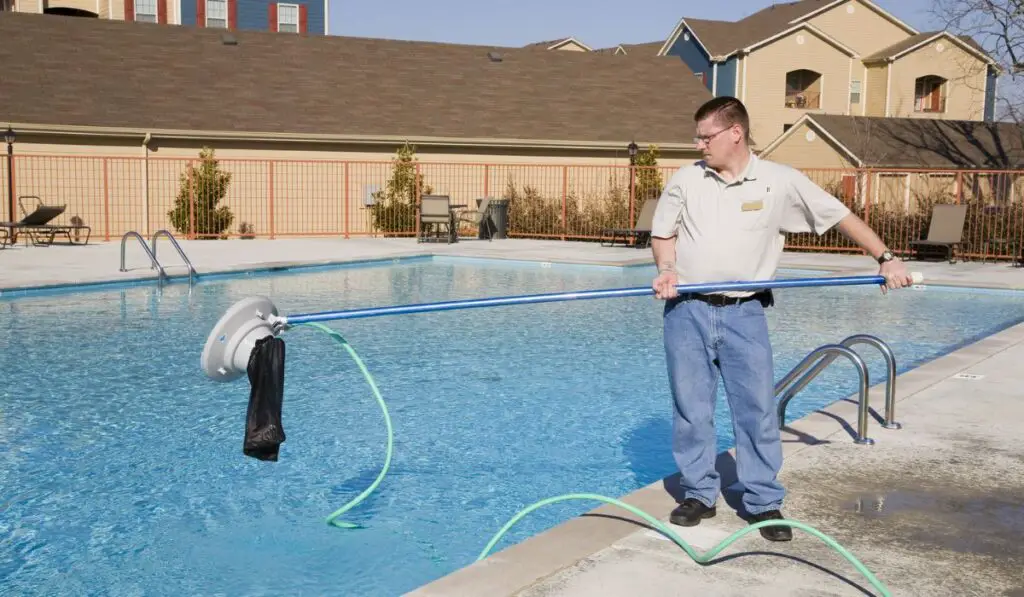Summer brings exciting days in the sun, splashing and playing in crystal-clear waters. What happens if your pool is cloudy? You can treat it, but what if it remains cloudy after being treated?
The best thing to do for a cloudy pool after treatment is to wait it out. Sometimes, it takes time for the water to clear. If all else fails, seek out the advice of a professional. In the meantime, it is not recommended to swim in a cloudy pool as the cloudy water may allow bacteria to grow.
To understand what to do with a cloud pool after proper treatment, you need to understand the cases of this cloudiness and potential further steps. Let’s look at more information about cloudy water that won’t go away.
Is Cloudy Water Dangerous?

Cloudy water isn’t always dangerous, but it isn’t a good idea to go swimming in it. There could be a severe imbalance of chemicals in the water or poor conditions that make putting your head underwater a risky choice for swimmers who do more than dip their toes in the liquid.
If the water is too cloudy, there is a chance you won’t be able to see someone drowning at the bottom. Look for the drain on the floor. If you can’t see it due to the cloudiness, you won’t be able to see a person lying on the bottom in an emergency.
Cloudy pool water could also mean there isn’t enough free chlorine in the pool, or the chemical is being diverted from flowing throughout the water. The liquid in the water might not be the cleanest, especially if there is something wrong with the chemicals or chlorine levels.
A cloudy pool is gross. It usually means the water is flowing with sunscreen, pee, sweat, spit, and other products and fluids that haven’t been filtered out of the sitting liquid.
Finally, if you have had cloudy water in your pool for some time, there could be a growth of harmful bacteria. Crypto, Giardia, Shigella, norovirus, and E. coli could all lurk in the liquid.
If the water in your pool is cloudy, the best course of action is to stay out. The cause could be harmless or seriously impact you and your loved ones’ health. It isn’t worth the risk a big gulp of contaminated pool water could bring into your body.
What Are the Most Common Causes of Cloudy Pool Water?
There are four prominent causes of cloudy pool water. Before panicking about your gross pool, examine these items to determine if there is a simple fix to the troubling appearance. Let’s dive into each of these potential problems.
Filter Issues
The first thing you should do is check the filter in your pool. Many filters go neglected, and this neglect could result in cloudy water. Particles floating in the water are the primary cause of gross water, and the filter is to blame for not doing its job.
The pump is the most critical part of the filter. It allows the water to flow into the system and push it through. Proper circulation is necessary for the filter to go through every bit of water in the pool. If the pump doesn’t work, the filter won’t work.
One of the best ways to check the status of the filter is to check the water pressure gauge. There is an established clean level for each pump. If the number on the device is eight or more above the clean level, it’s time to clean or replace parts.
There are two cleaning methods for an overdue filter. If you have a cartridge filter, remove and rinse it before reinserting it into the system. If you have a sand or DE filter, backwash it to clean out anything caught (here’s a guide for backwashing your sand filter).
Once you’ve cleaned the filter, run the system up to 24 hours a day for a few days to clear up the cloudiness. If it doesn’t go away, you could have another issue on your hands with the chemistry of the water.
Imbalanced Water Chemistry
Another common cause of a cloudy pool is an imbalance in the water chemistry. If the chemicals in the water aren’t right, they can help contribute to the pollution causing cloudiness in the system. Stay on top of your water chemistry to avoid cloudiness.
The best thing to do is test your pool water. Examine the pH, alkalinity, and calcium levels. If you find high pH, calcium levels above 400 ppm, or high alkalinity, they could cause your water’s unfortunate appearance.
A chemical imbalance that leads to cloudiness occurs when free chlorine attacks debris and dirt from bathers. Once the chlorine combines with the particles, it will form chloramines. If there are too many of these, they will fill up the pool and make it cloudy.
Stay on top of your water’s chemistry, even when the pool is crystal-clear. Test it a few times weekly to ensure you can make the necessary adjustments before a cloudy pool happens.
If you test the pool and find the water chemistry is standard, it isn’t the issue. Another potential cause could be low chlorine levels, leading to contamination of the swimming pool water.
Low Chlorine Levels

Low chlorine levels are another culprit of cloudy water. These low chlorine levels typically occur if there has been heavy rainfall, excess usage of the pool, or if it’s been a hot day. The UV rays from the sun oxidize much of the free chlorine and remove it from the water.
The best way to check for low chlorine levels is to test the water. If you see a result above .5 ppm, there is not enough chlorine present in the water and it isn’t safe to swim in. Keep individuals out until you can shock the pool to reclorinate the water back to safe levels.
To prevent clouding, use cyanuric acid or similar chlorine stabilizers to stop chlorine from leaving your pool. You only need to use a little bit – too much of a chlorine stabilizer will destroy the chlorine and cause cloudy water, reversing exactly what you tried to avoid.
If you want to add a boost of chlorine to your pool each day, liquid chlorine is an excellent choice. It doesn’t impact the chemistry of your pool and will keep everything stable to prevent cloudy water and growth.
You might test the chlorine levels and find they are completely normal. If that’s the case, contaminants are the final possibility.
Contaminants
The weather and environment around the pool can play a large part in the clarity of the water. There are a few items that could make their way into the water, leading to a cloudy appearance that won’t go away.
Algae is a possibility in an outdoor pool. In the early stages of its life, this plant will cloud the water and must be removed with a vacuum and then shocked to kill the remaining particles. To keep algae away in the future, ensure the chemical composition is balanced.
Another unwanted addition could be foreign particles, from body oils to sunscreen and urine. These may wash off while people swim and cause the water to cloud up. Nets and pool clarifiers are the easiest way to remove these items.
If your water is still cloudy, you’re running out of options. There are two more last resorts to try.
What to Do If Your Pool is Still Cloudy (After Checking The Above)
If none of the above items work after you’ve treated your pool, the best thing you can do is wait. After a treatment, it might take some time to clear. Give it a few hours, then check on the water to see if things look better.
If they don’t, cycle through the items mentioned above. Ensure you double-check the filter, chemical makeup, contaminants, and chlorine levels. Make any necessary fixes to get things back in line.
If your pool remains cloudy, don’t get back in, even if it seems safe. Keep yourself, your children, and your friends away from the water until it clears.
Once you’ve double-checked all possibilities and waited for a reasonable amount of time, it might be time to hand over the reins to someone with extensive experience with cloudy pools.
When to Call a Professional

If all your resorts are used up and you’ve done everything you can, it might be time to call a professional for assistance with your cloudy pool. They know what they are doing and will go over anything you forgot to find the solution to your swimming area appearance.
A professional will complete the following processes for you to ensure the quality of your pool:
- Cleaning: Professionals will scrub down your pool to remove any remaining residue or buildup.
- Testing: They will test for chemicals and chlorine levels to ensure everything is in tip-top shape.
- Chemical additions: Professionals will add the chemicals necessary to stabilize the pool’s composition for safe swimming.
They will ensure your pool is in tip-top condition for the best swimming.
A professional will also officially diagnose your pool to determine what is causing the persistent cloudiness. They will act to remove the cloudiness and bring you peace of mind to prevent stress when you should be enjoying your pool.
Although it isn’t always necessary to call a professional, they are very helpful if you are stuck and can’t get rid of the cloudiness after treatment.
